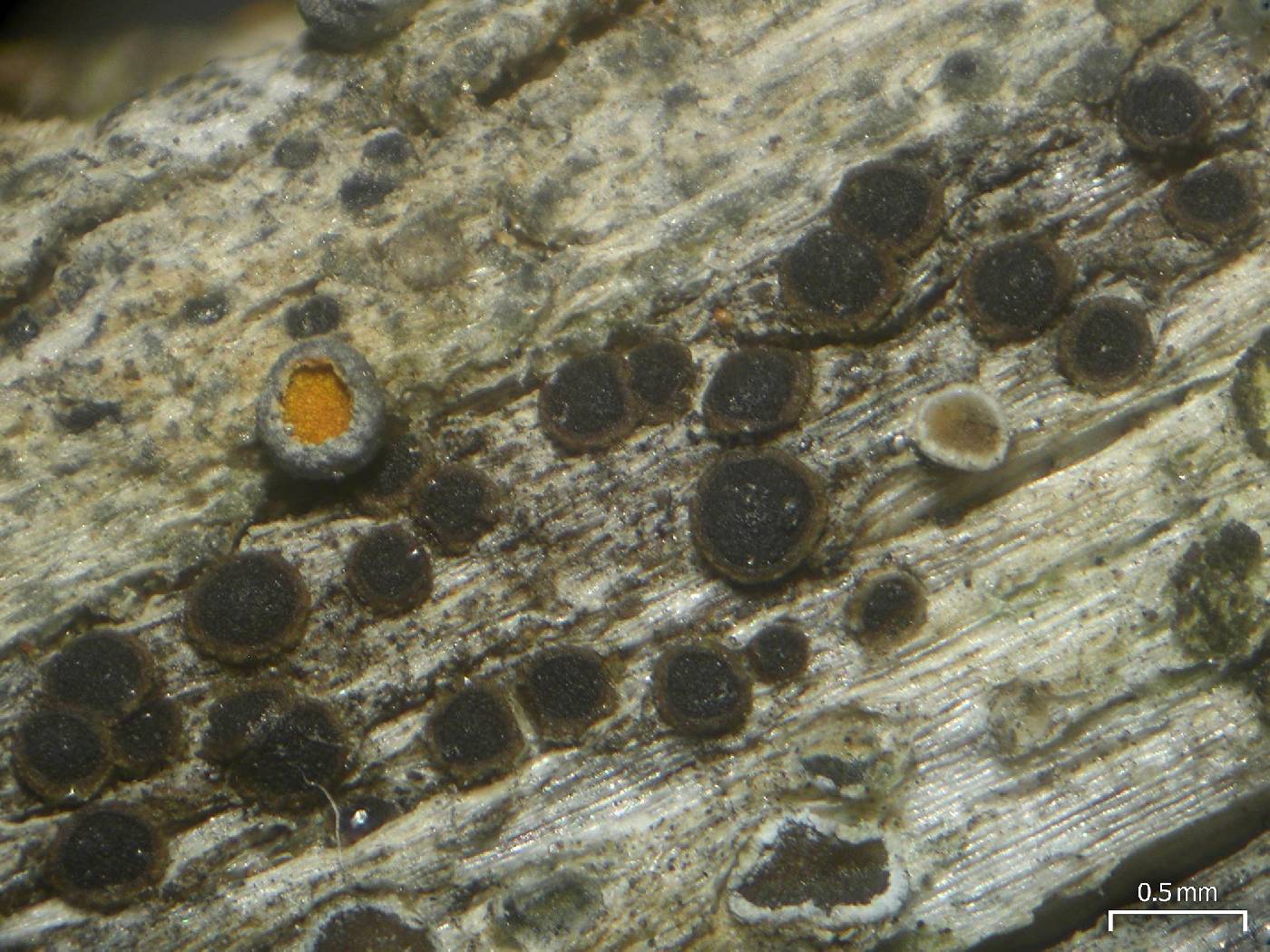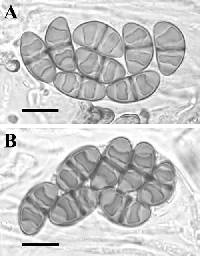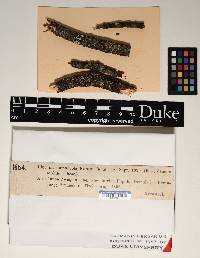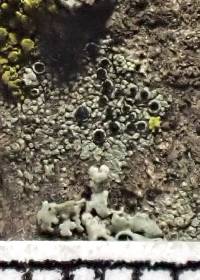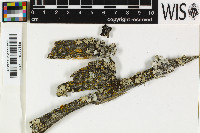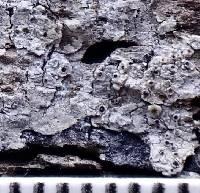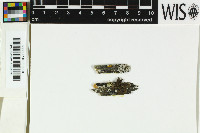
- Home
- Search
- Images
- Species Checklists
- US States: O-Z >
- US National Parks
- Central America
- South America
- US National Parks
- Southern Subpolar Region
|
|
|
|
Family: Physciaceae
[Rinodina glauca Ropin, moreRinodina magnussonii Sheard ined.] |
MB#370115 Type. SWITZERLAND. GRAUBÜNDEN. Engadin, Zernez, alte Zaunlatten, 1500 m, 16.VIII.1924, E. Frey s.n. (G - holotype!), BERNER OBERLAND. Diemtigtal, Grimmialp, 1280 m, 8 July 1934 E. Frey s.n. (G - paratype!). Rinodina glauca Ropin, Herzogia 9: 807 (1993). Exsiccatae. Brodo Lich. Can. Exs. 61 (CANL, MIN, WIS as R. archaea); Weber Lich. Exs. COLO 537 (CANL, SASK as R. coloradiana); Krypt. Exs. Vind. 3724 (M as R. laevigata). Description. Thallus thin, dark grey to grey‑green or grey-brown, or even copper-brown (on exposed substrates), inconspicuous or typically continuous to rimose, or thicker and areolate; areoles to ca. 0.70 mm wide; surface plane to somewhat rugose, matt; margin indeterminate; prothallus lacking; vegetative propagules absent. Apothecia broadly attached to narrowly attached, frequent, becoming contiguous, to 0.40-0.60 mm in diam.; disc dark brown (especially when wet), often becoming black, persistently plane, rarely becoming convex; thalline margin concolourous with thallus, prominent 0.05-0.10 mm wide, entire, sometimes becoming angular by compression, persistent; excipular ring often present, confluent. Apothecial Anatomy. Thalline exciple 55-80 µm wide laterally; cortex 5-15 µm wide; epinecral layer absent; crystals absent in cortex and medulla; cortical cells to 4.5-7.5 µm wide, pigmented or not; algal cells to (10-)14.0-18.0 µm long; thalline exciple 60-100 µm wide below; cortex 5-20 µm wide, cellular; proper exciple 5-10 µm wide laterally, expanding 20-30 µm at periphery; hypothecium (15-)30-70 µm deep; hymenium 60-100 µm high, not inspersed; paraphyses 1.5-3.0 µm wide, often conglutinate with apices to 3.5-6.0 µm wide, lightly or darkly pigmented, immersed in dispersed pigment forming a red-brown epihymenium; asci 45-65 x 12-18 µm. Ascospores 8/ascus, Type A development, Physcia‑type, (12.0-)15.0-16.0(-18.5) x (6.0-)7.5-8.0(-9.0) µm, average l/b ratio 1.9-2.1, canals sometimes disappearing as lumina become rounded, apices remaining thick walled; torus well developed, darkly pigmented at maturity; walls darkly pigmented, rarely with a faint pigmented band around each cell, not ornamented. Pycnidia immersed, ostioles dark brown; conidiophores Type I; conidia bacilliform, 3.5-4.0 x 1.0 µm. Chemistry. Spot tests all negative; secondary metabolites not detected. Substrate and Ecology. One of the most frequently collected Rinodina species in North America, found mostly on young branches of deciduous shrubs and trees but also on twigs of conifers (rarely foliicolous on Abies grandis and Thuja plicata), and occasionally on wood including fence posts. A pioneer species, R. freyi has been collected on a large number of species: Abies balsamea, A. concolor, A. lasiocarpa, A. magnifica, Acer glabrum, A. macrophyllum, A. negundo, A. rubrum, A. saccharum, A. spicatum, Alnus crispa, Amelanchier alnifolia, Arbutus menziesii, Betula lutea, B. occidentalis, B. papyrifera, Carya ovata, Cornus, Corylus, Fagus grandifolia, Fraxinus, Juglans, Picea engelmanii, P. glauca, P. mariana, P. rubra, P. sitchensis, Pinus banksiana, P. contorta, P. monticola, Populus balsamifera, P. grandidentata, P. deltoides, P. tremuloides, P. trichocarpa, Prunus virginiana, Pseudotsuga menziesii, Pyrus malus, Quercus macrocarpa, Rosa, Salix bebbiana, S. nigra, Sorbus, Thuja occidentalis, T. plicata, Tilia americana and Ulmus americana. Quite commonly collected with Amandinea dakotensis and infrequently with Rinodina albertana, R. archaea, R. aurantiaca, R. boulderensis, R. endospora, R. metaboliza, R. populicola, R. pyrina and R. stictica in different parts of its range. The species is found at 3,650 m in the western mountains. Distribution. In North America R. freyi is found in the northern mixed woodlands, parklands and southern boreal zones from the northeastern seaboard to the western mountains and coastal region. It is particularly abundant in the Great Lakes region. In the west it is distributed from Alaska to Arizona. It is remarkable that such a common and widespread species appeared so late in the North American literature (Brodo 1988, under the name R. magnussonii Sheard ined.), and again by Ropin & Mayrhofer (1993, as R. glauca). The distribution of this species is not well known in Europe but I have seen specimens from the Alps and Scandinavia. Notes. The species typically has a dark grey to brownish thallus and medium sized, Physcia-type spores with a prominent torus as illustrated in. The well developed apothecial margins and the frequent presence of an excipular ring, best seen in lighter coloured thalli, are other characteristic features of R. freyi. The morphotype with grey thalli corresponds to the type of R. glauca. Thalli growing in exposed situations have a brown, or copper-brown colour and often smaller spores, this form being common in the western mountains and the European Alps. The type of R. freyi occurs on wood from a fence railing and is characteristic of other specimens seen on this substrate (mainly from Europe). The apothecia are abundant, contiguous and mostly angular by compression, covering the whole surface of the thallus. Its thallus colour is dark copper-brown, presumably a response to the exposed habitat. The high density of apothecia gives the impression of a luxuriant growth form and may reflect the water holding capacity of the substrate. Magnusson (1947a) noted that the thalli of the type were maculiform, the small thalli following the grain of the wood. The term is also descriptive of the majority of specimens which typically have small thalli, often in positions where moisture is retained for a longer period than the rest of the substrate, such as the axils of twig branches or around leaf petiole scars. In a note attached to the holotype of Rinodina pyriniformis H. Magn. (= Amandinea dakotensis (H. Magn.) May & Sheard), Magnusson recognized this taxon as a new species but failed to publish it. This very abundant species often has been mistaken for R. archaea in herbaria, a species which is now known to be strictly western, possesses larger, Physconia-type spores, and found mostly on wood substrates. The ascospores of R. freyi are rather variable in size and very similar to those of the western R. boulderensis, a species which is distinguished by its light grey thalli and the presence of atranorin. Rinodina freyi has been confused with R. septentrionalis in Europe (Giralt & Mayrhofer 1995, Mayrhofer personal communication) but this species has a more northern, even arctic, distribution although there is some overlap of their distributions in continental North America. The confusion arises from the very similar spore size and morphology of the two species. Thalline characteristics, however, are typically quite distinct, R. septentrionalis having a copper-brown thallus consisting of small, discrete verrucae and possessing scattered, narrowly attached apothecia. This species may develop much larger thalli than R. freyi and only in very large thalli do the apothecia ever become crowded in the centre of the thallus and even then they are rarely contiguous. It is, however, difficult to distinguish very young specimens of the two species. At this stage of development, the thallus of R. freyi is not fully developed and the apothecia not yet confluent. In such cases, a search of the surrounding substrate frequently will reveal other thalli where the density of apothecia is greater and where most will be found to be contiguous. Specimens examined. CANADA. ALBERTA. 16 mi S Rocky Mountain House, C.M. Wetmore 20038 (MIN); Cypress Hills Interprov. Park, P.A. MacNeil 1861 1913, 2719, 2888, 2889; Elkwater Lake, P.A. MacNeil 4840 (all PMAE); Mount Edith Cavell, I.M. Brodo 31312 (CANL); Priddise, C.D. Bird 21546 (PMAE); Red Deer River, J. Marsh 4437, 4439 (ASU); Smoky Lake Campground, S.C. Tucker 9496 (MSC); Watridge Lake Trail, J.W. Sheard 5250 (SASK); Willow Creek, C.D. Bird 20762 (PMAE); Winfield, I.M. Brodo 31272b (CANL). BRITISH COLUMBIA. 15 km N Clearwater, C. Bjorke 9403 (Goward personal herb.); 1 mi SW Fernie, C.M. Wetmore 18714a (MIN); I.M. Brodo 15097 (CANL); 37 km N Clearwater, C. Bjorke 8667 (Goward personal herb.); Dawson Falls, I.M. Brodo 28531 (CANL); 1991, J.W. Sheard (SASK); Galiano Island, W.J. Noble 881a (UBC); Haida Gwaii (Queen Charlotte Islands), T. Tønsberg 32402 (BG); Spahats Creek Prov. Park, 1994, T. Goward (GZU); Summerland, 1991, J.W. Sheard (SASK); Trophy Mountain, R. Rosentreter 8778c (personal herb.); Vetter Pass Lodge, P. Williston 3870 (personal herb.); Wells Gray Prov. Park, 1994, T. Goward (GZU); Wokkpash Lake, I.M. Brodo 21578; Vancouver Island, Willis Point, I.M. Brodo 30939 (both CANL). MANITOBA. 35 km S The Pas, J.W. Sheard 5205; Cranberry Portage, J.W. Sheard 5203; Lake Winnipegosis, J.W. Sheard 5207, 5208 (all SASK); Payuk Lake, I.M. Brodo 31233 (CANL); Red Deer River, J.W. Sheard 5209b; Wanless, Rocky Lake, J.W. Sheard 5204 (both SASK). NEW BRUNSWICK. St. John Co., Saint John, H.R. Hinds 89 (UNB); Albert Co., Fundy Nat. Park, S. Gowan 2054, 2060, 2070, 2493, 4019 (personal herb.). NEWFOUNDLAND & LABRADOR. Shoe Cove Pond, T. Ahti 33958c (H). NOVA SCOTIA. Sable Island, D.H.S. Richardson 17a, 113b (NSPM). ONTARIO. Algoma Dist., near Elsas, B. McCune 26618 (personal herb.); Patterson Island, C.M. Wetmore 28826, 29376 (MIN); Carleton Co., 3.5 mi NE Almonte, P.Y. Wong 1326, 1328 (CANL, SASK); Brittania Bay, 1911, J. Macoun; Gloucester, 1975, M. Begin‑Robitail (both CANL); Ottawa, 1895, J. Macoun (MICH); 1975, M. Robitaille; Macoun Club Study Area, R.E. Lee 1335 (personal herb.); Vernon, P.Y. Wong 1217 (both CANL); Cochrane Dist, Ship Sands Island, C.M. Wetmore 5883 (MIN); Dundas Co., Winchester, P.Y. Wong 1226, 1238; Kenora Dist., 10 km E Winisk, R.A. Sims 2432 (all CANL); Lanark Co., Almonte, P.Y. Wong 1326 (MICH); Middlesex Co., Lieury, P.Y. Wong 1704; Ontario Co., Brooklin, P.Y. Wong 3188 (both CANL); Peel Co., Credit Forks, R.F. Cain 26809 (WIS); Peterborough Co., Burleigh Falls, P.Y. Wong 3168; Simcoe Co., Stayner, P.Y. Wong 1904 (both CANL); Thunder Bay Dist., 5 mi N Agawa Bay, J.W. Sheard 1534d; Brule Bay, J.W. Sheard 1581a; Kakabeka Falls, J.W. Sheard 1583, 1585b (all SASK); 1969, R. van Notte (CANL); S. Pickerel Lake, I.M. Brodo 13797 (SASK); near Raith, J.W. Sheard 1643a (SASK); Sibley Peninsula, I.M. Brodo 13797 (MIN, WIS); J.W. Sheard 1661, 1681b (SASK); 1.3 mi E Silver Island, I.M. Brodo 13748 (CANL); Timiskaming Dist., Lake Timagami, 1945, R.F. Cain (COLO); Whitewater Lake, I.M. Brodo 30919; Wellington Co., Little Lake, P.Y. Wong 2738 (both CANL). QUEBEC. Abitibi‑Ouest Co., Hebecourt, S.R. Clayden 1165 (personal herb.); Gaspé Co., Cap Gaspé, I.M. Brodo 20774; Penouille Point, I.M. Brodo 20740; Gaspé‑Est Co., 4 mi NE Gaspé, I.M. Brodo 18727b; Gatineau Co., Aylmer, I.M. Brodo 28894; Lac La Pêche, I.M. Brodo 16402b; Luskville Falls, J.W. Sheard 1430a; Îles‑de‑la‑Madelaine Co., Grosse Îsle, I.M. Brodo 20835a; Laval Co., Sainte-Dorothée, I.M. Brodo 16784a (all CANL). SASKATCHEWAN. Armit River Picnic Area, J.W. Sheard 5211a; Centre Block, Cypress Hills Interprov. Park, J.W. Sheard 5220; Emma Lake, J.W. Sheard 4703; Fort Esperance, J.W. Sheard 5263; Gooding Lake, J.W. Sheard 5201, 5202; Maligne Lake, J.W. Sheard 5200; Matheson Lake, J.W. Sheard 5245; Miko Lake, J.W. Sheard 5246; Prince Albert Nat. Park, 1994, J.W. Sheard; 5 mi SSW Waskesiu, J.A. Jesberger 1346; The Forks Prov. Picnic Site, J.W. Sheard 5251a; Vivian Lake, J.W. Sheard 5244 (all SASK). U.S.A. ALASKA. N Dyea, T. Tønsberg 32913; Mitkof Island, T. Tønsberg 32742 (both BG); Anchorage, 1993, J. Brune. ARIZONA. Apache Co., Mount Baldy, T.H. Nash 21291; Coconino Co., Grand Canyon Nat. Park, M. Boykin 2269, 2279; Grandview Trail, T.H. Nash 31037 (all ASU); Kachin Peaks Wilderness, T. Tønsberg 36399 (BG); Mount Humphries, T.H. Nash 35257; Oak Creek Canyon, T.H. Nash 8388; S.C. Tucker 12453; San Francisco Peaks, T.H. Nash 10803 (all ASU). CALIFORNIA. Eldorado Co., Eldorado Nat. Forest, S.C. Tucker 34060; Glenn Co., Plaskett Meadows, S.C. Tucker 37708 (both SBBG); Tehama Co., Lassen Nat. Forest, 1975, L. Sigal (ASU). COLORADO. Boulder Co., Boulder, 1976, W.A. Weber (SASK); 12 mi W Boulder, 1979, W.A. Weber (MICH); Boulder Canyon, 1979, W.A. Weber (COLO); Gregory Canyon, 1976, W.A. Weber (CANL); J.W. Sheard 4662, 4667; Lower Gregory Canyon, J.W. Sheard 4680; Upper Gregory Canyon, J.W. Sheard 4678 (all SASK); Clear Creek Co., Loveland Pass, I.M. Brodo 28686b (CANL); Grand Co., Rollins Pass, R.A. Anderson 6661 (COLM); Jefferson Co., NW Evergreen, J.W. Sheard 4695 (SASK). IDAHO. Benewah Co., Heyburn State Park, S.C. Tucker 36057B (SBBG); Gem Co., 14 mi N Ola, R. Rosentreter 8281 (personal herb.); Latah Co., NE Moscow Mountain, C. Bjorke 10538 (Goward personal herb.); Lewis Co., 3.2 mi W Mohler, W.B. Cooke 25082 (MU, WIS); Winchester, W.B. Cooke 25103 (WIS); Shoshone Co., 17.5 km NE Kellogg, C. Bjorke 10484, 10518-20 (Goward personal herb.). ILLINOIS. Cook Co., Somme Prairie, R.D. Hyerczyk 848 (MOR). MAINE. Aroostook Co., St. Francis, E. Lay, 96‑839 (personal herb.); Hancock Co., Little Moose Isla, T.J. Sullivan 2732 (MIN). MASSACHUSETTS. Berkshire Co., Great Barrington, E. Lay, 95‑1594; Hampden Co., Chicopee, E. Lay, 94‑18 (both personal herb.). MICHIGAN. Barry Co., 7 mi W Hastings, S.C. Wang 1164; Cheboygan Co., 6 mi SE Makinaw City, S.C. Wang 686; 7 mi N Wolverine, S.C. Wang 1206 (all MSC); Biological Station, R.C. Harris 8720 (MICH); Cheboygan, 1970, H.R. Hinds (SASK); 1972, J. Nimke (MICH); Douglas Lake, 1922, C.E. Nichols (FH); 1968, 1970, H.R. Hinds (SASK); Iron Bridge, B.C. Tan 79240 (CANL); Mackinaw City, 1970, H.R. Hinds; Pellston, 1970, H.R. Hinds (both SASK); B.C. Tan 79265 (CANL); Emmet Co., Van, 1970, H.R. Hinds (SASK); Wycamp Lake, R.C. Harris 9408 (MICH); Iosco Co., 4 mi W Alabaster, S.C. Wang 995; Keweenaw Co., nr Lac la Belle, H.A. Imshaug 58804 (both MSC); Livingston Co., along Tiplady Rd., R.C. Harris 10498; Mackinac Co., Cut River Bridge, R.C. Harris 12500a (both MICH); Midland Co., 6.5 mi S Coleman, S.C. Wang 1019; Montmorency Co., 4 mi S Atlanta, S.C. Wang 939; Muskegon Co., 6 mi NW Muskegon, S.C. Wang 1082 (all MSC); Oscoda Co., Mio, R.C. Harris 8226 (MICH); Wagner Lake, R.C. Harris 8235 (CANL); Otsego Co., 11 mi SE Gaylord, S.C. Wang 734; Roscommon Co., 6 mi S Prudenville, S.C. Wang 786; Sanilac Co., 13 mi NE Sandusky, S.C. Wang 1129; Tuscola Co., 3 mi NE Vassar, S.C. Wang 1117 (all MSC); Washtewaw Co., SE South Lake, R.C. Harris 10475 (COLO, MICH); Wexford Co., 9 mi W Cadillac, S.C. Wang 821 (MSC). MINNESOTA. Anoka Co., Bethel, T.D. Trana 10125; Becker Co., 20 mi NW Park Rapids, C.M. Wetmore 35868; Beltrami Co., 27 mi S Baudette, C.M. Wetmore 36459 (all MIN); Red Lake, B. Fink 969 (CANL); Clearwater Co., 1.6 mi W Itasca, C.M. Wetmore 20827, 20828 (WIS); Itasca State Park, C.M. Wetmore 20243, 20383, 20827, 20836, 26047; Cook Co., 1.5 mi SSE Phoebe Lake, T.D. Trana 14879; Grand Portage, C.M. Wetmore 68165c; Sawbill Lake, C.M. Wetmore 22159; Sugar Loaf Preser, C.M. Wetmore 75261; Dakota Co., Rosemount, S.O. Link 422; Goodhue Co., Cannon Falls, C.M. Wetmore 21398; Hubbard Co., LaSalle Creek, C.M. Wetmore 23295 (all MIN); Itasca Co., Highland Lake, B. McCune 24204 (personal herb.); Koochiching Co., 29 mi SE Baudette, C.M. Wetmore 36601; Big Falls, C.M. Wetmore 20556; Voyageurs Nat. Park, C.M. Wetmore 37377; Lake Co., 12 mi E Babbitt, C.M. Wetmore 27320 (all MIN); Denley Lake, C.M. Wetmore 27013 (CANL, MIN); Ely, C.M. Wetmore 26906; 16 mi SE Ely, C.M. Wetmore 27141; Kawishiwi Lake, T.D. Trana 14877; Mahnomen Co., Little Elbow State Park, C.M. Wetmore 23010; Mille Lacs Co., 6 mi N Princeton, C.M. Wetmore 22152 (all MIN); Otter Tail Co., 11 mi N Bluffton, C.M. Wetmore 36092 (MIN, WIS); Pennington Co., Thief River Falls, B. Fink 808, 811; Pine Co., 7.5 mi NE Danbury, J.P. Schuster 1147a (both MIN); Hinckley, J.P. Schuster 1275; Nemadji State Forest, J.P. Schuster 973 (both SASK); Ramsey Co., Larpenteur, M. Berbee 107; Roseau Co., Warroad, B. Fink 217; St. Louis Co., 21 mi N Ely, T.D. Trana 13486; 11 mi SE Aurora, C.M. Wetmore 30782, 30795; 10 mi S Babbitt, C.M. Wetmore 27813; Blind Ash Bay, C.M. Wetmore 32081 (all MIN); 16 mi S Ely, C.M. Wetmore 27358 (MICH, MIN); Hoyt Lakes, C.M. Wetmore 30683; Lac la Croix, C.M. Wetmore 57661; Slim Lake, T.D. Trana 13114; Voyageurs Nat. Park, C.M. Wetmore 30973, 31871 (all MIN); C.M. Wetmore, 32063 (CANL, MIN); C.M. Wetmore 32845, 33044, 33773, 33787, 38462, 38932, 39157, 39886, 40271; Wadena Co., Huntersville, C.M. Wetmore 25719; Washington Co., 4 mi NE Marine, C.M. Wetmore 22003; Lost Valley Prair, J.P. Schuster 2458 (all MIN). MONTANA. Beaverhead Co., Canyon Creek, B. McCune 20639; Glacier Co., Saint Mary Lake, B. McCune 19280a (both personal herb.); Madison Co., Wade Lake, B. McCune 12341; Sanders Co., Cabinets Mountains, 2000, M. Hauk (both SASK). NEW HAMPSHIRE. Coos Co., White Mountains, 1852, E. Tuckerman (FH). NEW JERSEY. Sussex Co., Delaware Water Gap, C.M. Wetmore 56294 (MIN). NEW YORK. Clinton Co., Altona, E. Lay 96‑837 (personal herb.); Erie Co., Buffalo River, G. Wilhelm 13984 (MOR); Greene Co., Catskill Park, E. Lay 96‑840; Ulster Co., Catskill Park, E. Lay 96‑836 (both personal herb.). OREGON. Crook Co., Ochoco Mountains, B. McCune 20448 (personal herb.); Jackson Co., 1 mi NE Gold Hill, S.C. Tucker 37131 (SBBG); Lane Co., Adaptive Management Area, B. McCune 24519; Linn Co., N Mowich Lake, B. McCune 23782 (both personal herb.). UTAH. Duchesne Co., N Fork Duchesne River, C. Newberry 719; Summit Co., Uninta Mountains, C. Newberry 1433 (both BRY). WASHINGTON. Spokane Co., Dishman Hills, C. Bjorke 10148a (Goward personal herb.); Stevens Co., 'The Wedge', 2004, K. Ahlenslager (WYU). WISCONSIN. Ashland Co., Basswood Island, C.M. Wetmore 60044; Bayfield Co., Rainbow Lake Wilderness, C.M. Wetmore 70531 (both MIN); Squaw Point, I.M. Brodo 5839a (CANL); Douglas Co., Brule Barrens, J.W. Thomson 2148; Brule River, J.W. Thomson 1937 (both UPS); Superior, J.W. Thomson 1432 (UPS); Madison Co., Madison, 1927, A.W. Evans (MICH); Marathon Co., 3 mi E Rothschild, G. Newberry 71; Oneida Co., Big Stone Lake, W.L. Culberson 1600; Vilas Co., Eagle River, J.W. Thomson 2129 (all WIS); Johnson Lake Barrens, E. Lay 02‑199, -200 (personal herb.). WYOMING. Park Co., Dunavon Picnic Area, C.M. Wetmore 81154 (MIN). Selected References. Harris (1977 Figs. 153, 154 as R. archaea and R. exigua), Brodo (1988 as R. magnussonii Sheard ined.), Ropin & Mayrhofer (1993 p. 784 as R. glauca), Thomson (2003 as R. archaea and R. glauca), Sheard (2004 as R. glauca). Nash, T.H., Ryan, B.D., Gries, C., Bungartz, F., (eds.) 2004. Lichen Flora of the Greater Sonoran Desert Region. Vol 2. Thallus: crustose, evanescent or thin, of discrete verrucae, up to 0.15-0.25 mm wide, becoming contiguous and continuous or rimose, plane or more usually rugose surface: dark gray to red-brown, dull; margin: determinate or indeterminate; prothallus: lacking; vegetative propagules: absent Apothecia: sessile or adnate, frequent, sometimes contiguous, dispersed on smooth bark, up to 0.4-0.6 mm in diam. disc: dark brown (especially when wet), sometimes becoming black, persistently plane thalline margin: concolorous with thallus, 0.05-0.1 mm wide, entire, sometimes becoming flexuose, persistent; excipular ring: visible in gray thalli, confluent thalline exciple: 50-70 µm wide laterally; cortex: 5-10 µm wide; epinecral layer: 5 µm wide, rarely present; cortical cells: up to 5-7.5 µm wide, pigmented; algal cells: up to 14-18 µm in diam.; thalline exciple: 70-100 µm wide below; cortex 5-15 µm wide, also cellular proper exciple: 5-10 µm wide laterally, expanding to 15-30 µm at periphery hymenium: 60-80 µm tall; paraphyses: 2-3 µm wide, conglutinate, with apices up to 4-5 µm wide, lightly pigmented, usually immersed in dispersed pigment forming a light red-brown epihymenium; hypothecium: hyaline, 30-40(-70) µm thick asci: clavate, 45-65 x 12-18 µm, 8-spored ascospores: brown, 1-septate, ellipsoid, type A development, Physcia-type, (11.5)14-15.5(-18) x (5.5-)7-8(-9.5) µm, lumina angular at first, canals mostly disappearing as lumina become rounded, apices remaining thick walled; torus: prominent at maturity; walls: not ornamented Pycnidia: not seen Spot tests: all negative Secondary metabolites: none detected. Substrate and ecology: mostly on smooth bark of deciduous trees and twigs of conifers World distribution: Europe (the Alps and Norway) and North America (Great Lakes region to northeastern seaboard states and provinces, and Rocky Mountains, southern Alberta and British Columbia to New Mexico) Sonoran distribution: Arizona in Apache and Coconino Counties, at elevations of 1740-2960 m. Notes: Rinodina glauca typically has dark, Physcia-type spores with a relatively prominent torus giving the appearance of a very dark transverse septum. The spores are reminiscent of R. boulderensis, a species that is easily distinguished by the light gray thallus with atranorin in the cortex. In the Great Lakes region, R. glauca is wholly comparable with European material examined. The western population has smaller spores and may prove to be a different species. |

